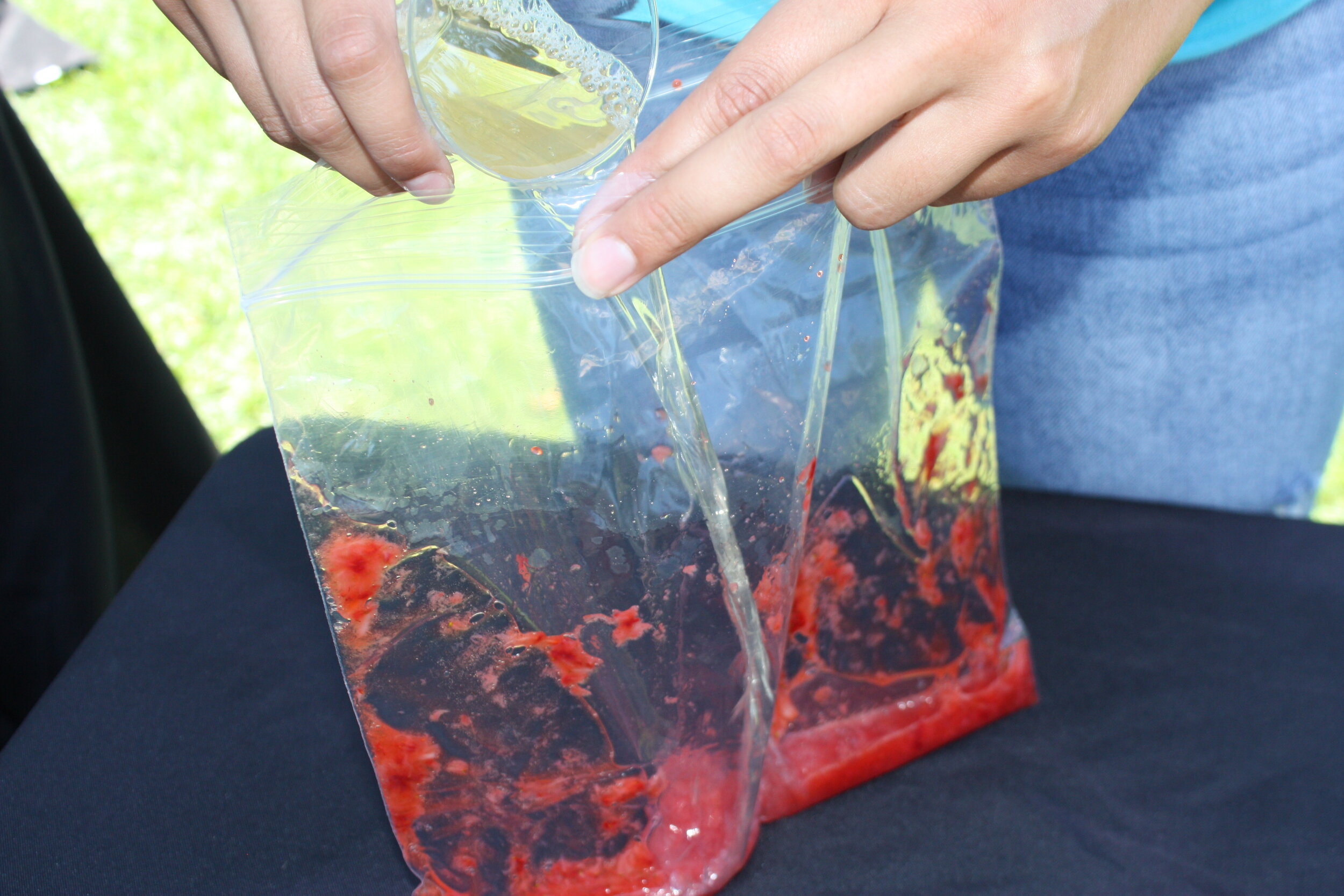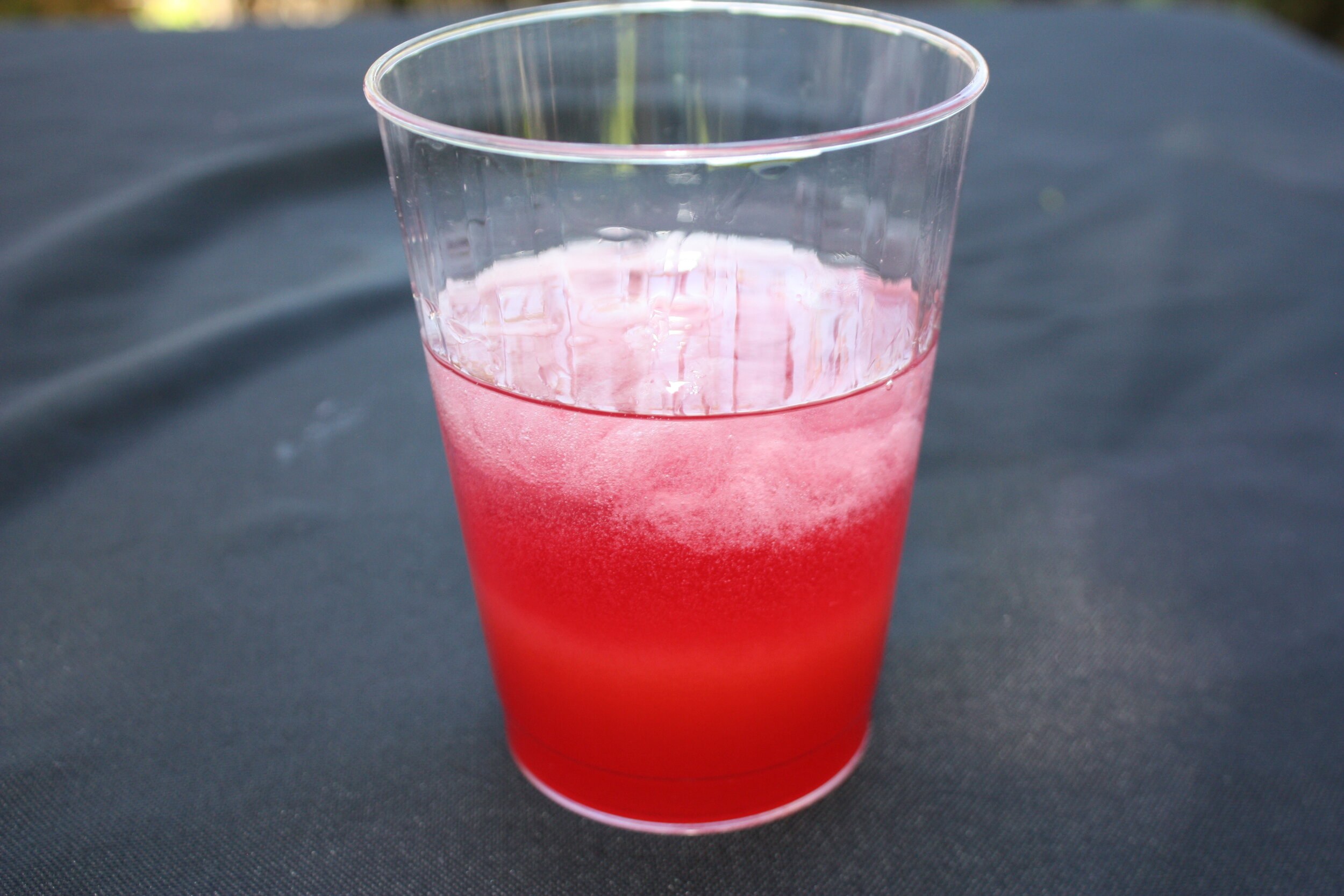Strawberry DNA Extraction
In this experiment, you’ll learn how to extract the DNA from any fruit or vegetable. The best part is that you can find all the ingredients in your house, no scientific lab needed!
Standards in this lesson: NGSS 2-LS4-1, NGSS 1-LS3-1, NGSS 3-LS3-1, NGSS 3-LS4-2, NGSS 4-LS1-1, NGSS MS-LS1-1
Materials
2-3 decent-sized strawberries (frozen or fresh, it doesn’t matter)
gallon-size resealable plastic bag
2 teaspoons of dish soap
1 teaspoon of salt
½ cup of water
1-2 wooden popsicle sticks (or something else you can stir with)
2-3 clear plastic cups
1-2 coffee filters
Rubbing alcohol
Procedure
Step 1
Grab your strawberries. If they still have any green leaves on them, ask a grown-up to help you cut them all off. If you are using frozen strawberries, make sure you let them defrost before beginning the experiment.
Step 2
Once prepared, put your strawberries into the plastic bag. Make sure it is sealed tightly, then start to gently smash them. To prevent the bag from popping, try to let most of the air out of the bag before you seal it. Don’t stop mashing the strawberries until they are a pulpy liquid.
Step 3
In one of the plastic cups, combine and mix together the dish soap, salt, and water with a popsicle stick. This makes our lysis solution (lyse, like the cleaner lysol, means “to loosen” or “to break apart”).
Step 4
Pour all of the lysis solution into the plastic bag with the strawberry puree. Make sure it is sealed tightly once again and with the least amount of air possible. Then, begin gently mixing the lysis solution and the strawberry puree. Instead of smashing like you did with the strawberries, try swishing the solution around to mix it with the strawberries. Make sure there are little to no bubbles created in the bag while you mix its contents together.
Step 5
Next, place the coffee filter over a new cup. Grab your strawberry solution and slowly pour it over the coffee filter and cup. You might need a friend to help hold the coffee filter steady so it doesn’t collapse into the cup. Once most of the strawberry solution has been poured over the coffee filter, gather the edges and hold them together like a makeshift coffee filter pouch. Gently squeeze the coffee filter so that the puree goes into the cup. We only want the liquid part in the cup and the bigger strawberry pulp chunks left in the coffee filter. If the filter breaks and/or you spill a lot of the mixture in the cup, just grab another coffee filter and/or cup and refilter the mixture.
Step 6
Then, grab the rubbing alcohol. Pour it in the cup with only the liquid part of the strawberry until there are equal amounts of rubbing alcohol and strawberry solution. Don’t stir the mixtures together. Just let them sit in the cup for a few seconds and leave them alone. After you let the solutions settle, you’ll see a white cloudy substance on the top. Pick this up with a wooden popsicle stick. Observe the strawberry DNA!
Science Explanation
Kindergarten - 2nd Grade . . .
- As you probably know, there are many different types of plants and animals in our world across both the land and the water. How many different kinds of plants and animals do you think exist on Earth?
- There are 8.7 million different organisms on Earth! What are some differences between some plants and animals? Are there any similarities?
- Every living thing has something called DNA. DNA is like an instruction manual for your body, providing it with information on what color your hair should be and what shape your nose is.
- Differences in our DNA are what makes every plant and animal so different! But while our DNA makes us different, you may have noticed that you look very similar to your parents. What are some traits that you share with your parents?
- Your DNA is a mixture of your mom’s DNA and your dad’s DNA. So, we end up looking like a mixture of our parents!
- NGSS 2-LS4-1
- NGSS 1-LS3-1
3rd Grade - 5th Grade . . .
- As you probably know, there are many different types of plants and animals in our world across both the land and the water. How many different kinds of plants and animals do you think exist on Earth?
- There are 8.7 million different organisms on Earth! What are some differences between some plants and animals? Are there any similarities?
- Every living thing has something called DNA. DNA is like an instruction manual for your body, providing it with information on everything, including what color your hair is and what shape your nose is.
- Differences in our DNA are what makes every plant and animal so unique!
- These differences between individuals of the same species can give some an advantage over others. For example, a rabbit with fur that can blend in with its surroundings might be able to hide from predators more than a rabbit with fur that does not blend in. A plant that tastes bad might get eaten less than a plant that tastes good.
- But while our DNA makes us different, you may have noticed that you look very similar to your parents. What are some traits that you share with your parents?
- Your DNA is a mixture of your mom’s DNA and your dad’s DNA. So, we end up looking like a mixture of our parents!
- You may think that you look very different from some of your friends, but 99.9% of DNA is the same for all humans. In fact, most plants and animals have very similar DNA. Human DNA is about 60% similar to banana DNA!
- The traits that make an individual live and reproduce (like rabbit fur color and plant taste) are passed down from parent to offspring. Over time, these traits become adaptations: traits that make an organism suited to its environment.
- Can you think of any other adaptations? Some examples might be larger ears to hear predators, sharp teeth to catch prey, thorns to protect plants, flowers to attract pollinators.
- NGSS 3-LS3-1
- NGSS 3-LS4-2
- NGSS 4-LS1-1
Middle School . . .
- As you probably know, there are many different types of plants and animals in our world across both the land and the water. How many different kinds of plants and animals do you think exist on Earth?
- There are 8.7 million different organisms on Earth! What are some differences between some plants and animals? Are there any similarities?
- Every living thing has something called DNA. DNA is like an instruction manual for your body, providing it with information on everything, including what color your hair is and what shape your nose is.
- The DNA in our bodies is typically found within cells, which are like small little rooms with different structures that keep the cell alive, and therefore, keep the entire organism alive.
- All living things have cells, even plants, and all of them utilize DNA within them. Differences in our DNA are what makes every plant and animal so unique!
- But while our DNA makes us different, you may have noticed that you look very similar to your parents. What are some traits that you share with your parents?
- Your DNA is a mixture of your mom’s DNA and your dad’s DNA. So, we end up looking like a mixture of our parents!
- You may think that you look very different from some of your friends, but 99.9% of DNA is the same for all humans. In fact, most plants and animals have very similar DNA. Human DNA is about 60% similar to banana DNA!
- NGSS MS-LS1-1
Written by Ethan Kirgan and Alina Silva
Inspired by: The National Human Genome Research Institute (Video)









